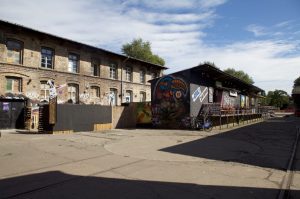
Born out of the desire to experiment with and give shape to new forms of public art practices, ZK/U is a polymorphic space that functions as a research hub, a local community space and as a repository of ideas fuelling social change within the city of Berlin. Behind ZK/U lies the artist collective KUNSTrePUBLIK, whose decade-long work in the public scenes is marked by a strong orientation towards socially-conscious and locally-embedded projects. Since 2012, ZK/U community of artists and researchers have implemented initiatives that examines urban life by using art as an analytic lens, although always mantaining a direct and practical connection with physical spaces and local realities.

Maré (or Complexo da Maré), in the northern periphery of Rio de Janeiro, is a complex of several favelas with 130.000 inhabitants stacked on 10 sq.km. The Museu da Maré was created by popular initiative to reclaim and de-stigmatise the identity of the neighbourhood. Tesserae researchers had the chance to visit the place and get in contact with the promoters thanks to the CoCreation project.

A Prussian railway workshop, a Cold War industrial wasteland, a contemporary socio-cultural center in the heart of Berlin Friedrichshain. The area is emblematic of collective and informal processes of creative transfomation reinventing Berlin’s urban landscape. The R.A.W. in Berlin-Friedrichshain was originally serving as a railway workshop in the XIX century. After being damaged during World War II and undergoing various transformations, it became a neglected wasteland in post-unification Berlin. In 1999, the RAW-Tempel association repurposed the site for artistic and cultural activities, aiming to create a vibrant hub for creativity and community engagement. In 2015, the Kurth Group acquired ownership of R.A.W. and recognized its potential for investment and urban development. Unlike other financial actors, the new owner aimed to respect the site’s identity and socio-cultural programs, giving long-term residents more control over their pre-existing properties. Establishing a participatory approach to urban planning, new plans for the R.A.W. Tower, a 100-meter-tall building, was set to be constructed starting in 2024. The project is intended to blend with older activities, integrating new offices, green areas, markets, and other services, with the R.A.W.’s role as a cultural institution. However, concerns about power dynamics and possible future compromises between top and bottom interests revolving around the R.A.W. might still challenge the current collaborations between the community and external investors.